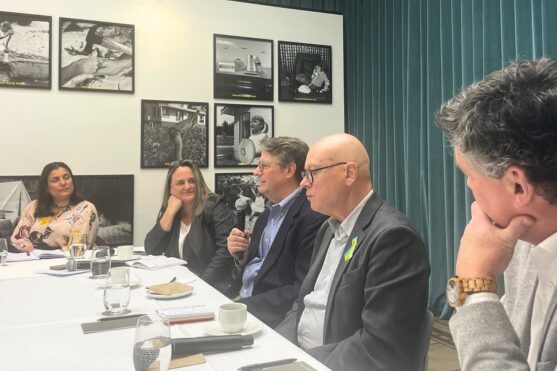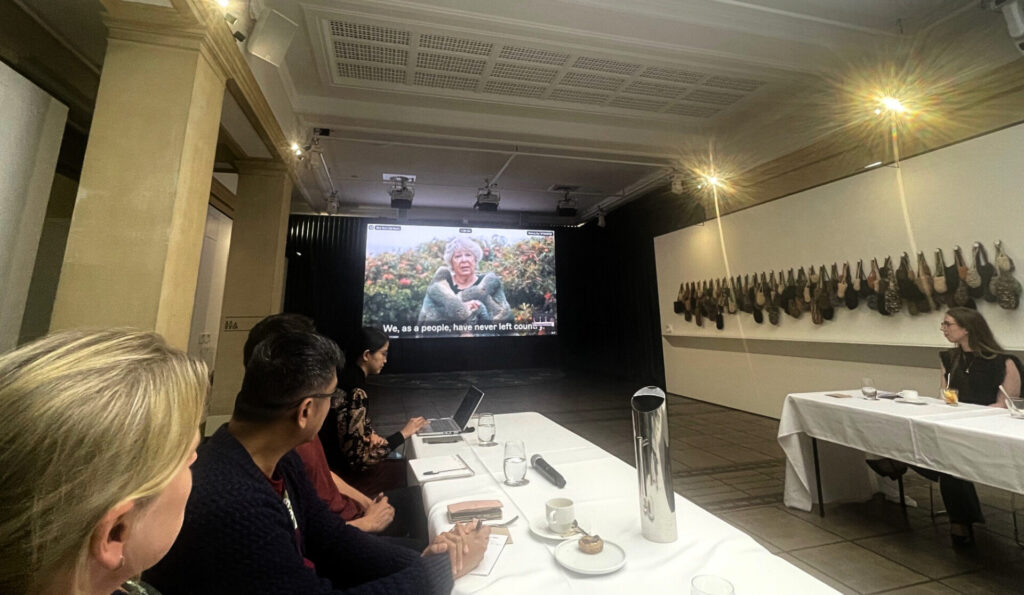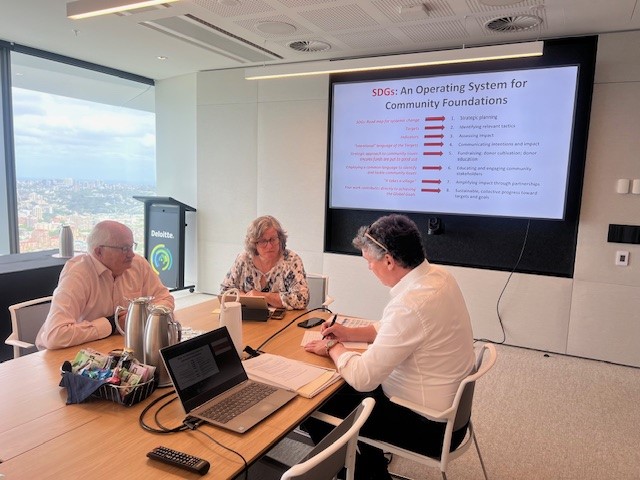Mott Foundation: How can SDGs help philanthropy achieve greater social impact?

Community Foundations Australia CEO Ian Bird and Philanthropy Australia’s CEO Maree Sidey spoke with Nick Deychakiwsky, senior program officer at the Charles Stewart Mott Foundation, and Dr Larry McGill during an event in Sydney this week. Larry is a philanthropic data expert, former VP at Candid in the US and founder of Ambit 360 Consulting. The US-based Mott Foundation commissioned Larry to investigate how the Sustainable Development Goals (SDGs) could provide a ready-made shared framework for foundations to achieve greater social impact collectively. Philanthropy Weekly shares an overview of their fascinating conversation.
Nick and Larry are speaking at events in Sydney, Canberra, Adelaide and Melbourne, thanks to the generosity of Philanthropy Australia’s friends at Community Foundations Australia (CFAus). Ian outlined how CFAus was testing the application of the SDG framework in the contexts of housing, readiness to learn, and food systems in workshops with Nick and Larry.
The Mott Foundation is going to be 100 next year and Nick outlined how its founder, Charles Stewart Mott, who passed away in 1972, cared deeply about the relationship between the community, the individuals in it and the mutual responsibility they have to each other. Nick spoke of the importance of enabling a good legal and regulatory space for philanthropic work, something that Mott Foundation has invested in throughout the world.
“There’s also the necessity for good standards and practices to be shared for effectiveness – practices for inclusiveness, accountability, transparency. So, the Mott Foundation has been a supporter of the philanthropic non-profit sector, or more broadly, civil society infrastructure for decades,” he said.

The SDGs allows diverse parties to work together on an issue
Larry talked about how he had worked with the Mott Foundation to introduce the SDG framework to community foundations as an operating system or currency that allows diverse parties to work together on an issue. The SDGs were created to help solve “some of the world’s biggest problems” and are a useful tool for philanthropy to ask what part it is contributing to those global goals.
Philanthropy is contributing but may not know it, he said. “One of the challenges is doing it with intentionality – understanding what the goals are and understanding the kinds of things you’re already doing that are contributing towards those goals.”
One of the drivers of community foundations in the US to engage with the SDGs was that they found it was a useful tool for measuring impact. “Because the SDG framework is comprehensive, because it identifies the fact that there’s a whole constellation of issues that need to be addressed, and that these issues are interrelated, that serves as a mapping tool for figuring out where you are in terms of your work and how it relates to the rest of the work that needs to be done to achieve these goals,” said Larry.

“You understand that what you’re doing is a piece of the puzzle and that it takes partnership to achieve the kinds of systemic changes that the SDGs are aspiring for.” He pointed out that under each of the big SDGs, there lists of targets, actions and indicators of progress. “So, actually in the SDGs, you have a built-in system for beginning to think about how you would measure your own impact.” And that measure can be used to work in tandem with others on the same goals – notwithstanding the challenges of data sharing.
Maree said that the framework Nick and Larry were applying to community foundations also applies to the wider sector and philanthropic foundations. She highlighted that a long-standing “pain point” for Philanthropy Australia has been the collection and aggregation of data for the sector. She said that the biggest issue was around articulating the argument for why sharing data is important and how it enables collaboration.
Why is sharing data critical to creating a strong sector voice?
Larry responded that to achieve systems change, foundations need to think beyond the specific purposes they want to fund individually. Shifting the needle on an issue such as healthcare, for example, won’t happen by giving to specific individuals or organisations, he said. It will happen “because there’s community that will take action on the basis of a collective idea”. “You need to work collectively and understand the indicators are that you’re trying to move.”
Sharing data is important to professionalise the sector at the very least, but more strategically than that Larry said, it is vital to create a strong voice, otherwise the sector’s voice is not more powerful or influential than that of a single foundation. “Power comes from having the data that backs up the collective input of those numbers. So, it [sharing data] largely derives from wanting to make sure that philanthropy as a sector has a voice,” said Larry.
Larry said that if foundations are collecting data in their own way with their own taxonomy, it’s difficult to unify. He described the work of the Foundation Center in the US that aggregated data on philanthropic entities taken from the tax system and was a “library of information about funders”. “Now what would be ideal is if the foundations themselves contributed that information voluntarily, because taking all that information from government forms and then codifying it takes a lot of person power.”
Foundations tend to use their own taxonomies because they make sense in their own context, but this is where Larry and Nick suggest that using the SDG framework makes sense “as a bridge from the taxonomies that are used intuitively to … ways of talking about the collective impact that we’re trying to make,” said Larry.

Global trends – sources of wealth, the ‘polycrisis’ and tech
Nick spoke about the trends he’s seeing around the world. “The thing that gets articulated more and more is the growing wealth inequality. There is more questioning of the sources of wealth, so this idea that you must be good because you’re giving … as a holder of wealth doesn’t cut it anymore.
“There’s a greater recognition of the role that philanthropy can and does play. This is something that the philanthropy ecosystem, particularly WINGS, has been great at championing. A lot of philanthropic funding is catalytic, often risk capital… this is a good thing, but it could a double-edged sword… “governments might be nervous”. “Philanthropy can play a quite an influential role,” he said.
“There is a lot of talk about the so-called polycrisis we’re facing of climate change, increasing migration, more visible conflict in the world, wealth inequality. So, there’s an understanding that philanthropy really does have a role to play in trying to grapple with these global challenges.
“But these global challenges are also local and that is another thing that is happening in philanthropy … and international development – talk of the need for localisation. That it’s not all some big grand institution sitting somewhere in the clouds… but that they need to ensure people are involved in decision-making and designing solutions, not just in implementing them.
“And finally, the effect of technology … and dilemmas we’re seeing with disinformation, misinformation, data privacy and the like. But there are also a lot of good things that technology can do to civic tech and to enable good social progress to happen. But philanthropy is still learning and is a still a little bit of a deer in the headlights in relation to how do we grapple with the significant changes that technology is putting in front of us,” said Nick.
The report Larry produced for the Mott Foundation on how to use the SDGs to help measure impact can be downloaded from its website. Visit Communities Foundation Australia to learn more.